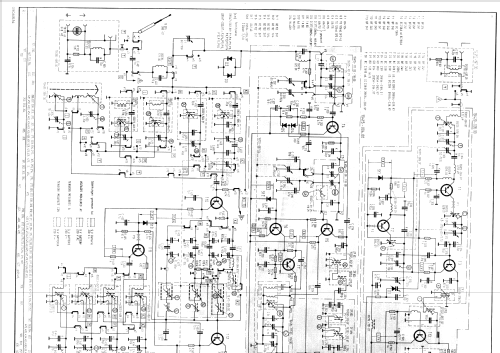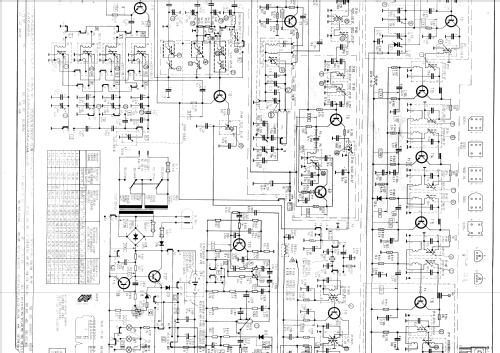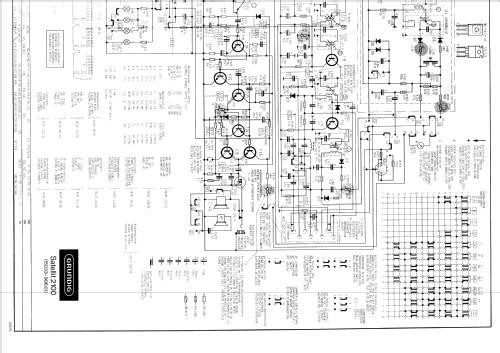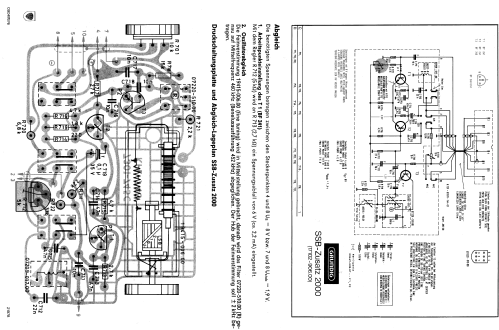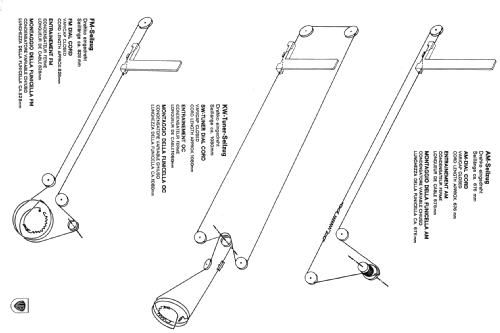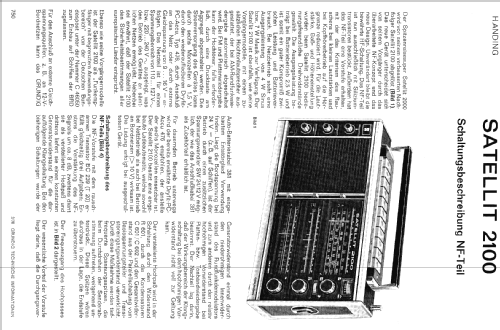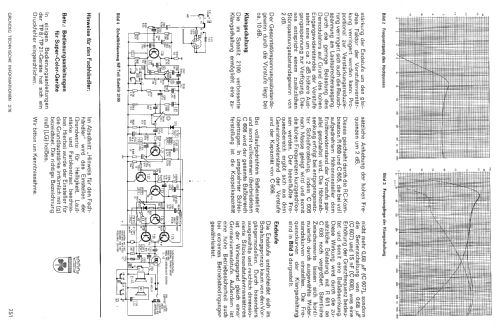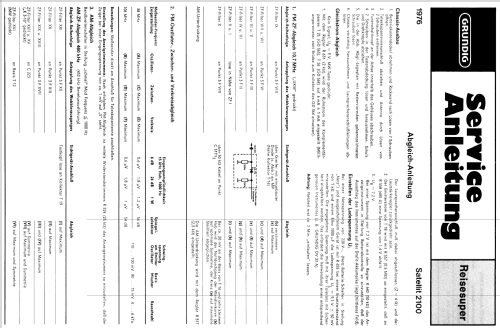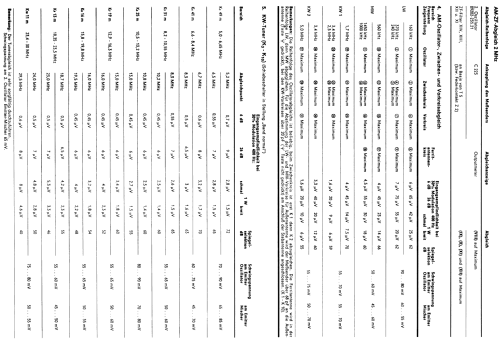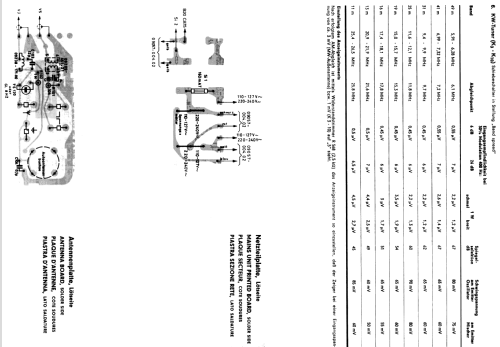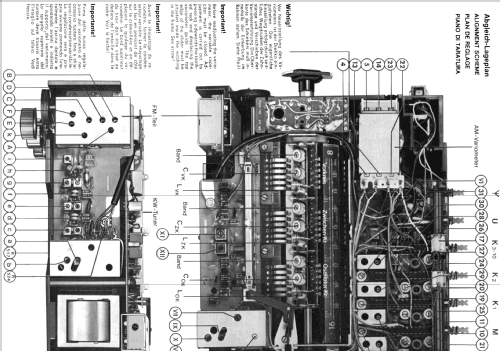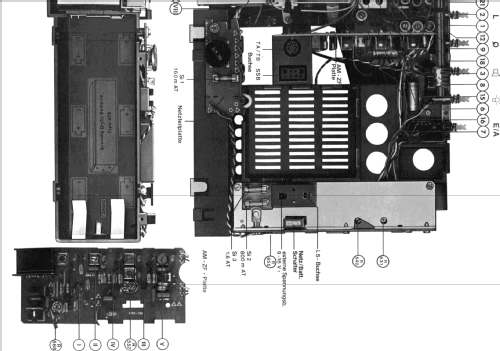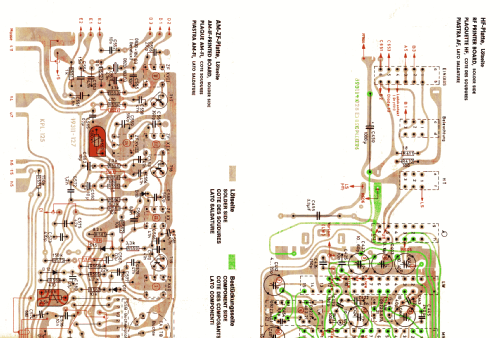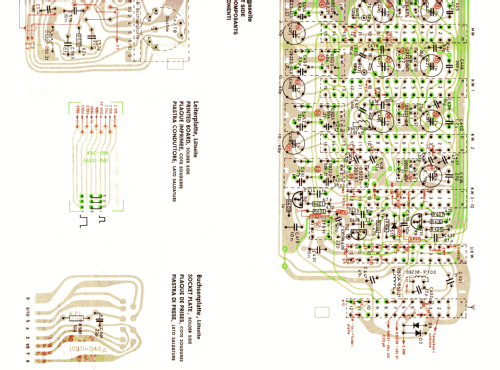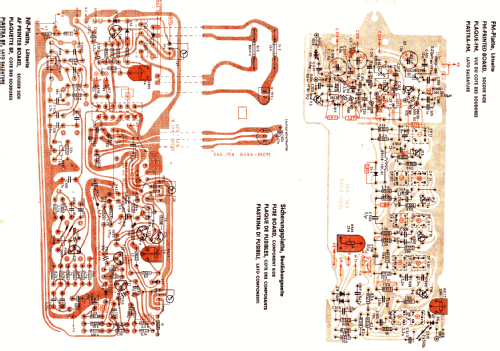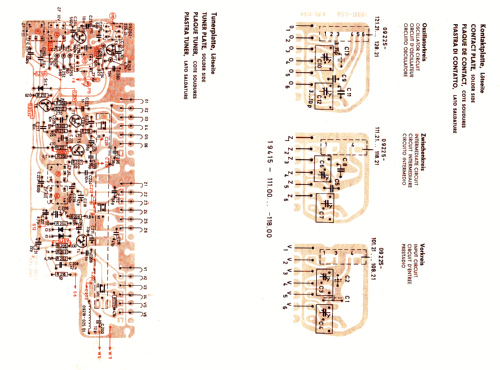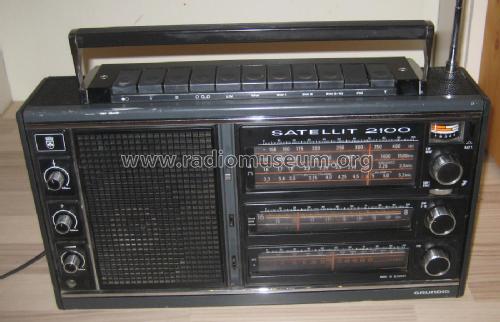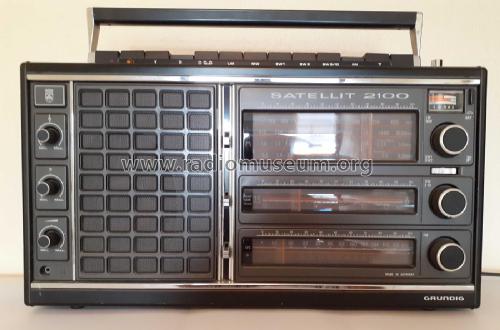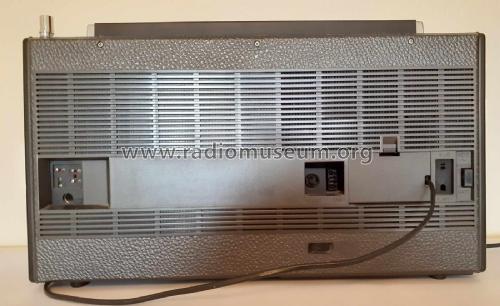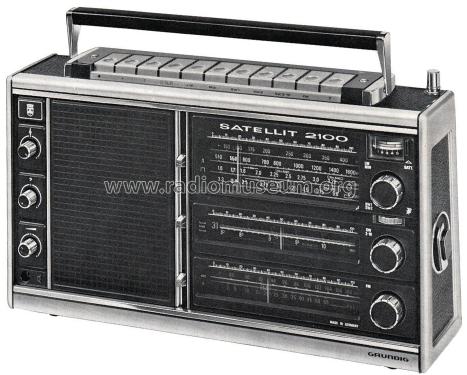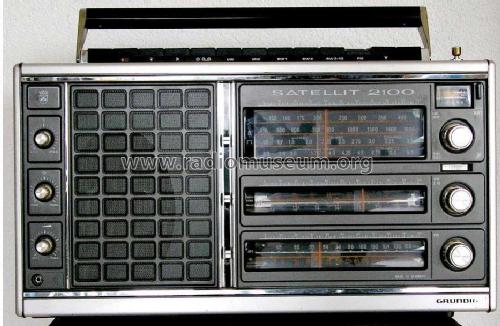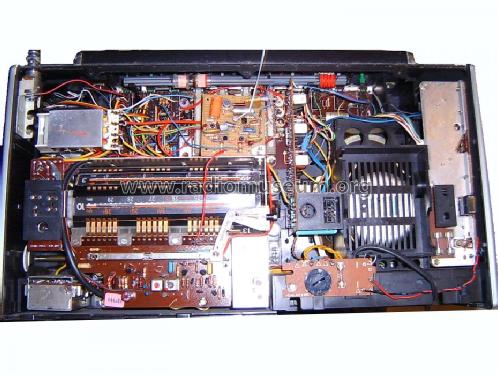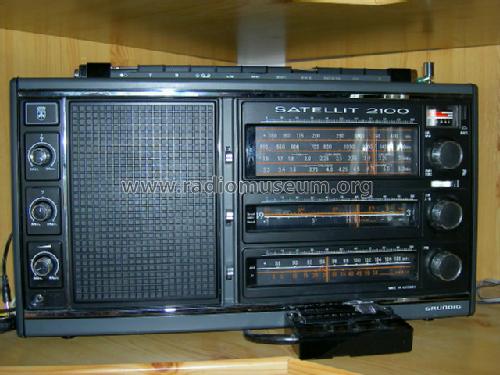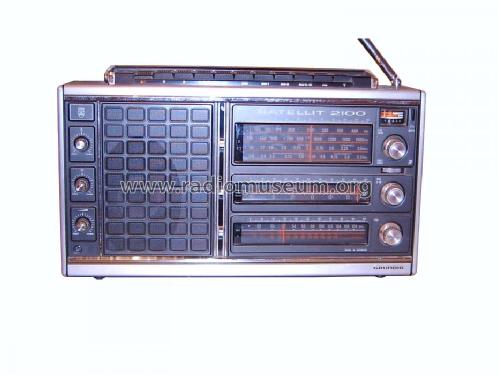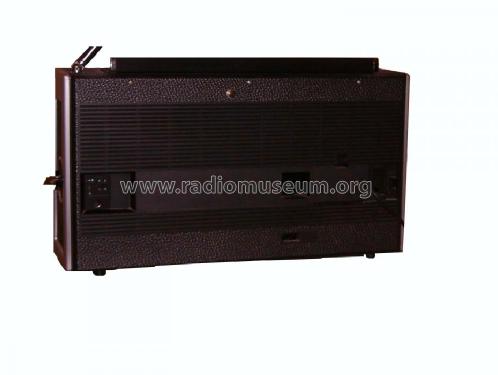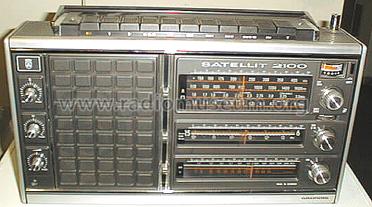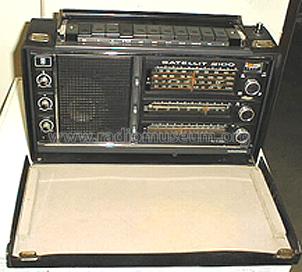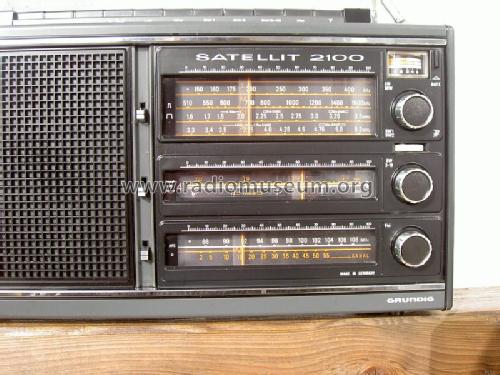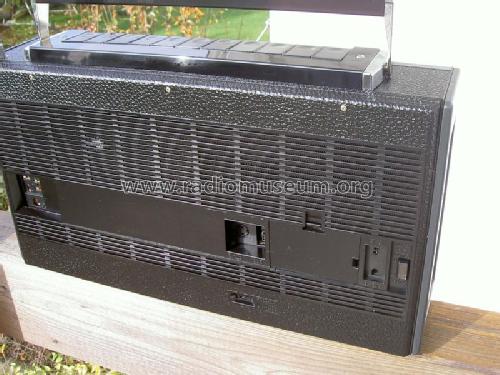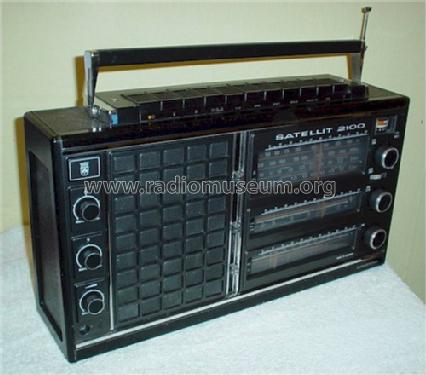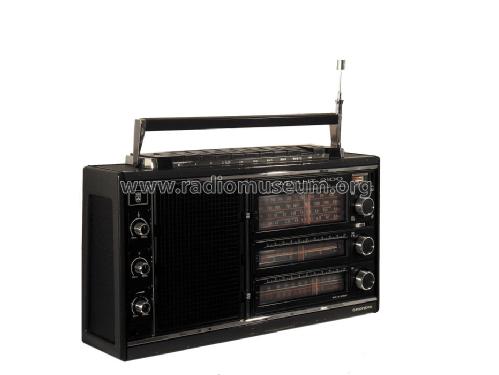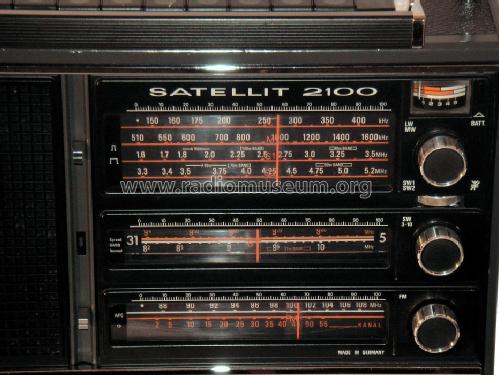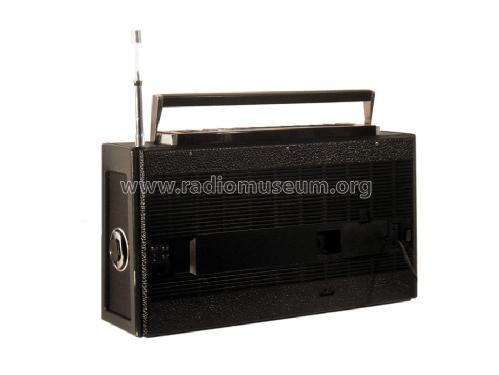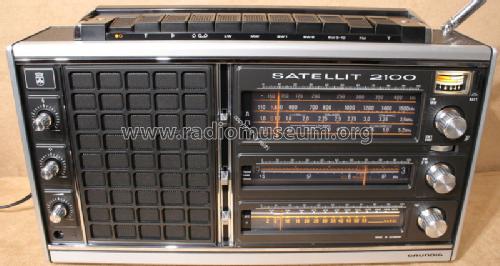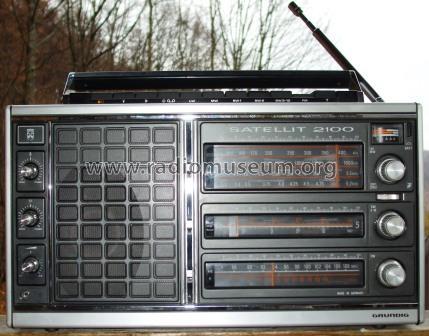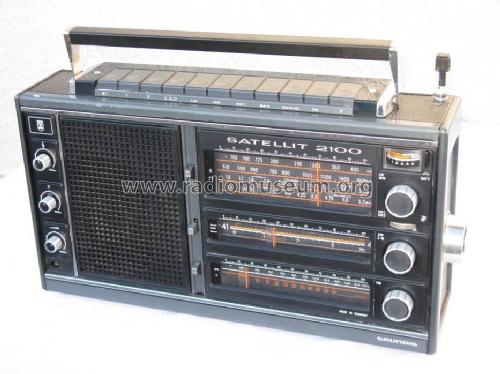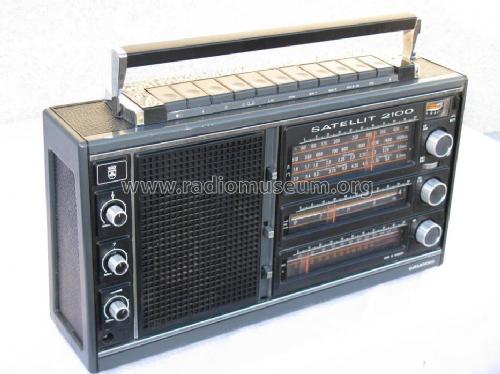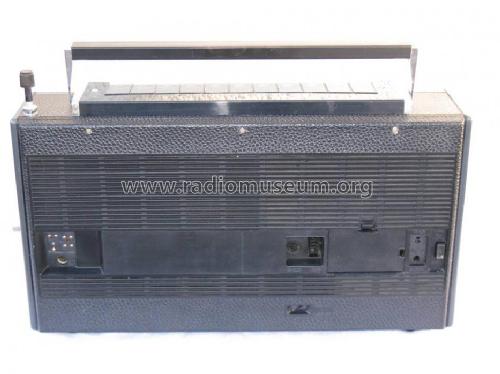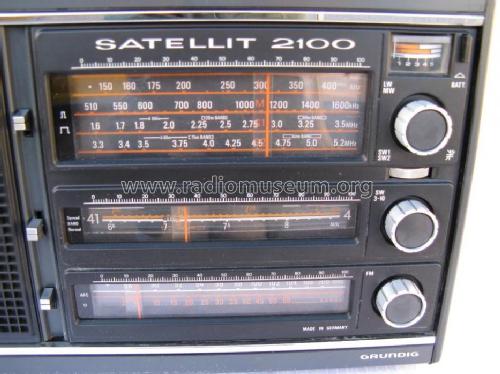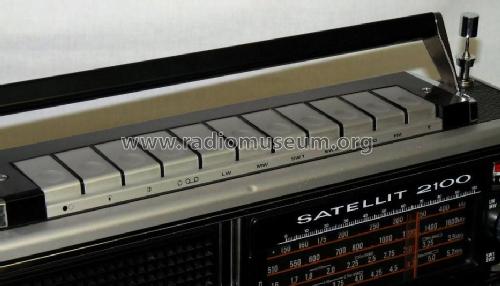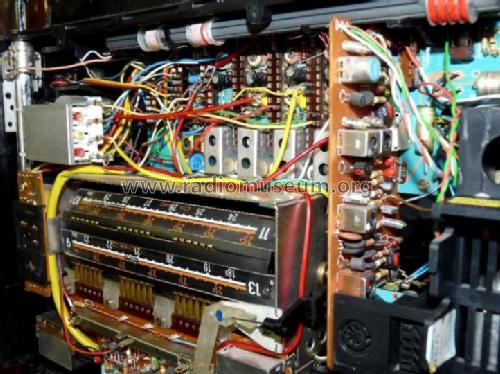Satellit 2100
Grundig (Radio-Vertrieb, RVF, Radiowerke); Fürth/Bayern
- Pays
- Allemagne
- Fabricant / Marque
- Grundig (Radio-Vertrieb, RVF, Radiowerke); Fürth/Bayern
- Année
- 1976–1979
- Catégorie
- Radio - ou tuner d'après la guerre 1939-45
- Radiomuseum.org ID
- 71607
-
- alternative name: Grundig Portugal || Grundig USA / Lextronix
Cliquez sur la vignette du schéma pour le demander en tant que document gratuit.
- No. de transistors
- 27
- Semi-conducteurs
- Principe général
- Super hétérodyne, conversion double ou triple; FI/IF 2000/460//10700 kHz
- Circuits accordés
- 13 Circuits MF (FM)
- Gammes d'ondes
- PO, GO, plus que 2 x OC et FM
- Tension / type courant
- Secteur et Piles (tous types). / 110-127; 220-240 / 6×1,5 Volt
- Haut-parleur
- 2 HP
- Puissance de sortie
- 2.5 W (qualité inconnue)
- Matière
- Plastique moderne (pas de bakélite, ni de catalin)
- De Radiomuseum.org
- Modèle: Satellit 2100 - Grundig Radio-Vertrieb, RVF,
- Forme
- Portative > 20 cm (sans nécessité secteur)
- Dimensions (LHP)
- 460 x 270 x 120 mm / 18.1 x 10.6 x 4.7 inch
- Remarques
-
Grundig Satellit 2100: Bandbereiche L, M, K1 (1,6 - 3,5 MHz / 187 - 85 m), K2 (3,3 - 5,2 MHz / 90 - 58 m), K3 - K10 (5 - 50 MHz in 8 etwas überlappenden Bereichen mit schaltbarer Bandspreizung für das 49, 41, 31, 25, 19, 16, 13, 11 m - Rundfunkband).
In den Bereichen L, M, K1, K2 9 Kreise, Einfachsuper; nur in den Bereichen K3 - K10 Doppelsuper mit erster ZF 2 MHz, zweiter ZF 460 kHz, 14 Kreise.
Im UKW-Bereich ZF 10,7 MHz, schaltbare AFC, schaltbarer Hochtonlautsprecher.
Ausgangsleistung bei Batteriebetrieb 2,5 W, bei Netzbetrieb 4 W Sinus, 7 W Musik. Schaltbuchse für externe Speisespannung 9···16 V.
Anschluß für den SSB-Zusatz 2000. Bei der Beneluxausführung beträgt die zweite AM - Zwischenfrequenz 452 kHz statt 460 kHz. Entsprechend muß die Mittelfrequenz des BFO - Zusatzes eingestellt sein.
Kosmetisch wurde das Design des Geräts wiederholt etwas verändert:
- erste Ausführung: silberne Drucktasten, feineres Lautsprechergitter
- Profi - Look: Schwarze Drucktasten, feineres Lautsprechergitter
- letzte Ausführung: Satellit 3000 - Look: "waffelförmiges" Lautsprechergitter, silberfarbene Drehknöpfe
- Poids net
- 6.3 kg / 13 lb 14 oz (13.877 lb)
- Source extérieure
- eigene Sammlung
- Source
- Handbuch VDRG 1977/1978
- Schémathèque (1)
- -- Original-techn. papers.
| Grundig_Kurzwellenfibel_Sattelit_2100_3000 | 4596 KB |
- Documents sur ce modèle
- Auteur
- Modèle crée par Johannes Bernhauser. Voir les propositions de modification pour les contributeurs supplémentaires.
- D'autres Modèles
-
Vous pourrez trouver sous ce lien 6250 modèles d'appareils, 5496 avec des images et 4251 avec des schémas.
Tous les appareils de Grundig (Radio-Vertrieb, RVF, Radiowerke); Fürth/Bayern
Collections
Le modèle Satellit fait partie des collections des membres suivants.
- Juan Almagro-Lopez (E)
- Johannes Bernhauser (A)
- Peter Boll † 30.5.24 (D)
- Martin Bösch (CH)
- Martin Fichtinger (A)
- Rainer Friedrich (D)
- Jörg Holtzapfel (D)
- Winfried Höller (D)
- Dimitrios Karas (GR)
- Rolf Leonhardt (D)
- Vladimir Manannikov (RUS)
- Sofronios Markidis (GR)
- Gianluigi Miazzi (I)
- Ryan Murphy (IRL)
- Manuel Albano Neves (P)
- Elvira Orasch (A)
- Fred Overbeek (NL)
- Jaroslav Pochyly (CZ)
- Museum Roggenhofer (A)
- Siegfried Ross (D)
- Fabio Sarcina di Fidio (I)
- Dieter Schulte-Kulkmann (D)
- Sándor Selyem-Tóth (H)
- Alois Steiner (A)
- Davide Tambuchi (I)
- Francisc VISKY (RO)
- Dominik Wulf (D)
Littérature
Le modèle Satellit est documenté dans la littérature suivante.
Contributions du forum pour ce modèle: Grundig Radio-: Satellit 2100
Discussions: 2 | Publications: 8
Sehr geehrte Sammlerkollegen,
Habe vor einiger Zeit einen Satellit 2100 in kaputtem Zustand bekommen. Äußerlich keine Schäden also ein Objekt für eine Restauration.
Ich habe erstmal die Tastatur repariert, es fehlte ein Feder und der Rand der die Feder hält bei der Schadow Tastatur.
Danach funktionierte die Tastatur ohne weitere Reinigung.
Ich habe es dann noch behutsam ausgeblasen, alle Lämpchen erneuert, die Kontakte des Trommeltuners radiert, ich hatte sogar noch eine neue Antenne aus meiner Kurzwellenzeit... Die Skalen und Nadeln wurden gereinigt
Gerät ist jetzt wunderschön wie neu aber...
Nur bei UKW verzerrt er vor allem im Tieftonbereich. Bei AM scheint es normal zu sein. Habe auch den AUX Eingang ausprobiert, der geht auch einigermaßen.
Es scheint also nur FM diese Verzerrungen zu produzieren.
Beim SAT 1400 habe ich eine Meldung über diesen Fehler gefunden, vielleicht sind die Schaltungen ja ähnlich.
Ich habe die hier downloadbaren Pläne, aber keine Lagepläne und keine Stücklisten von dem Gerät.
Wäre sehr froh wenn mir ein Grundigfan Tips gäbe.
Liebe Grüße und Danke
Michael
Michael Gasperschitz, 17.Apr.12
Hello,
I would like to share an experience with all of you regarding repairs on a Satellit 2100, although this problem/solution will apply to all old radios. I was recently reassembling my Satellit 2100 after doing some recapping and a transistor replacment (L.O. transistor on SW 3-10) when I noticed that LW,MW,SW1 andSW2 were completely silent. I shotgun replaced the L.O. transistor here as well (being to lazy to troubleshoot the circuit!) and the problem persisted. I was very dissapointed as the radio played so well just minutes before. FM,SW3-10 still worked properly. For the next few hours I studied the schematic, tested components looked at waveforms on the scope,(there was clearly no local oscillator) even compared voltage readings with a working set to no avail. In utter desparation, I decided that the only component I hadn't tested was the tuning condenser.I connected my digital ohmmeter to the leads which I disconnected from the switch assembly, and I measured 180 ohms. Rotating the shaft made no changes in the reading. I looked carefully at the stator and rotor and could not understand the 180 ohms. Getting out the most powerful eye loupe I could find, I noticed a few strands of Dendrite (check Google for a definition if you don't know about dendrite) between the stator and frame. compressed air was then liberally applied and the 180 ohms dissapeared... Moral of the story: always clean your tuning condensers before wasting a day troubleshooting!! Good Luck, I hope this helps someone someday! Ross
Ross Hochstrasser, 17.Aug.07
